“Only thoughts that occur to you while walking are of value” – Friedrich Nietzsche
Foto’s: Ilya Rabinovich
Is there a connection between your head and your feet? Can walking be a way to better understand yourself and the world? Philosophers, writers and artists have been working on this for centuries. According to Kierkegaard, the mind functions best at a walking pace of 4.5 kilometers per hour.
This autumn we are deviating from the beaten track with Mind Your Step, a programme about the art of walking. We are not only presenting an exhibition in het Glazen Huis, but also walks and audio tours developed by the artists. Put on your walking shoes!
Mind Your Step walks are converted into maps, drawings and documentation. All of this will be on display in het Glazen Huis, so that the exhibition itself is constantly moving and connected to the world outside.
Exhibition in het Glazen Huis
In his works, Tim Knowles explores movements through the landscape to depict the relationships between things. The video installation In Search of the Miraculous II by Tom Bekkers consists of 5 filmed performances recorded in the Wadden area, in which the artist reflects on climate change while walking while he slowly sinks further and further into the mud. We show a new version of Rundgang/Walk Round by Iris Hoppe with two different points of view during a walk through the streets of Amsterdam and Zuid-Kennemerland. Chikako Watanabe develops an installation outside het Glazen Huis in which she weaves together stories around the park. During the exhibition she develops this further with the help of the visitors. The movements in Naomi Bueno de Mesquita‘s web app Walkaway can be followed in real time on a screen.
Staged walks, audio tours and walks & talks in the Amstelpark
Liesje van den Berk takes you into the park to experience the environment while drawing instead of through the lens of your phone (drawing experience or talent is not necessary).
Naomi Bueno de Mesquita presents Walkaway, a web app that allows walkers to ‘erase’ streets on the map of Amsterdam by walking through them, which can beseen in real time on a screen in het Glazen Huis.
For a new version of his audio walk Secret Signals, Justin Bennett recorded the barely audible sounds of trees and plants in the park.
Malú Cayetano Molina & Sonia Pérez investigate with the participants in Atmospheres (Body as Sensors) how the human body, as a sensor, picks up signals from the environment .
Ienke Kastelein stimulates the senses with the twilight walk Don’t walk into the woods at night and leads a cheerful happening with white chairs in Walking White Chairs. Isolde Venrooy gives instructions to see new connections and possibilities in the world around us, and Esther Hovers ‘ audio tour invites us to experience the city differently, during a walk from the Amstelpark to the neighboring Zuidas.
More information and public programme
Read on for more information about the artists and their projects or click through to the public program with all the individual events that will take place in addition to the exhibition and the walks. If you have any questions, please email projects@zone2source.net
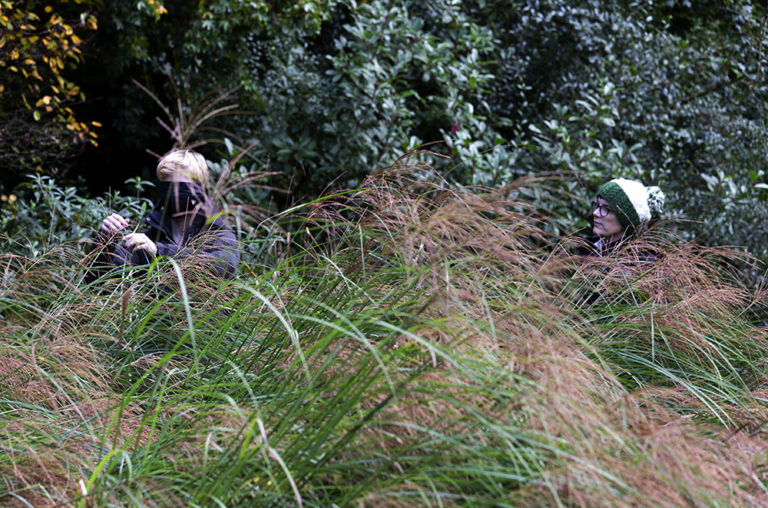
Image: Ilya Rabinovich
Artists
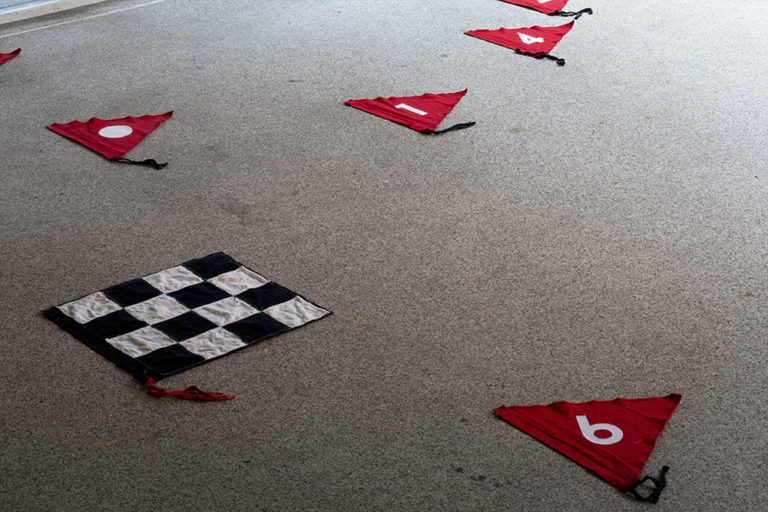
Image: Ilya Rabinovich
Tim Knowles,
Paths of Least Resistance
Windwalk – 7 dials – Waiting for Godot
Track#1
Tim Knowles works with various media, photography, video, drawing and light installations to
investigate our movements across the country. Knowles creates process-oriented work that is based on chance and environmental elements. In his projects he incorporates experiences of nature in which he uses phenomena such as wind and weather. In the Glass House he shows three works:
Path of Least Resistance acted as a mechanism to dictate the routes of people, entering unknown and unmarked terrain. While the starting points and the finish were known, the route was directed by a set of rules and the landscape itself. The participants walked as if they were water flowing from the land and tried to find their way to the sea, pulled by gravity. Each individual carried a GPS logger that recorded their path. This data was then used to create a drawing constructed from the multiple tracks, revealing the nature of the landscape and requiring participants to follow the rules. The drawing is displayed on the windows of the Glass House along with some photographs and artifacts.
Windwalk – 7 dials – Waiting for Godot is part of a series of walks guided by the wind using a series of mechanisms, filmed and plotted with GPS. The drawing, presented on the windows, shows how as the wind runner’s meandering route [guided solely by the wind through a helmet with a sail] collides with buildings, walls, railings, ventilation shafts, parked vehicles to provide a glimpse of the structure of the city is revealed. The drawing of the route is shown together with the wind helmet and a photo.
In Track 1 the artist followed traces of human passage through the landscape. This sequence of signs – broken ferns, bent grass, footprints, broken twigs, compressed moss, broken stones and dislodged rocks – became the inspiration for a series of photographs of these signs or marks framed in the landscape. Forensically, the photographs are presented in a row on the floor, and together the images reveal the process of the subtle signs that acted as the impetus for an unknown person’s journey through the open landscape.
timknowles.co.uk
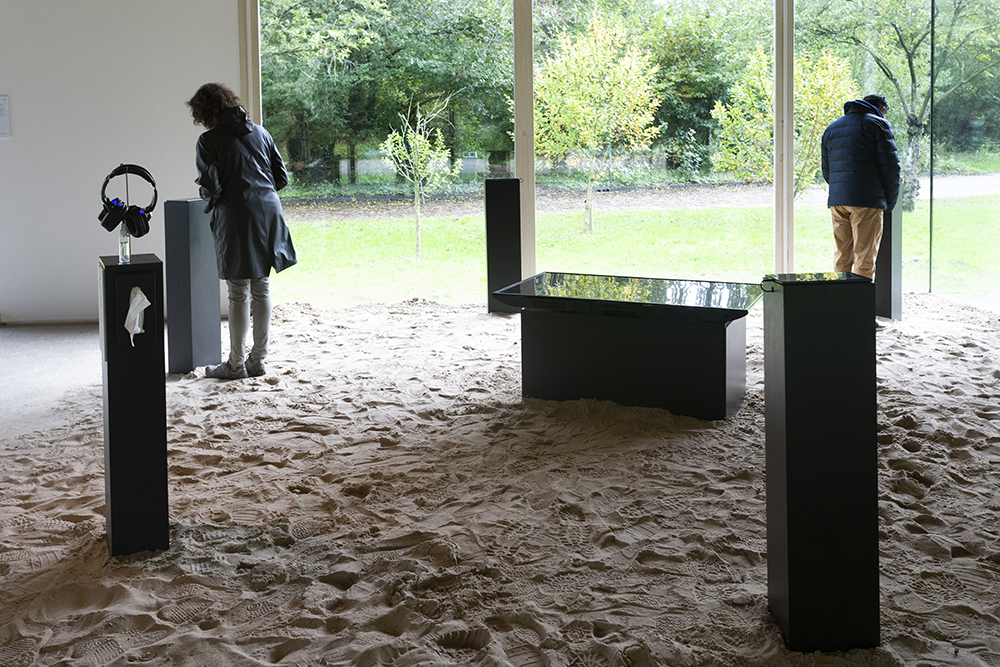
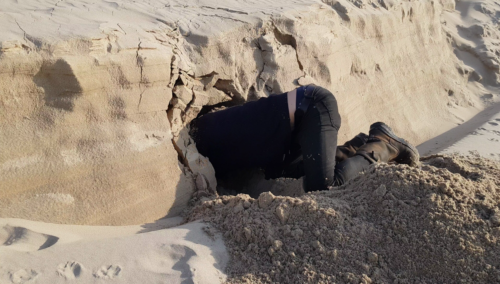
Photo: Tom Bekkers, Ilya Rabinovich
Tom Bekkers, In Search of the Miraculous II
This video installation consists of five filmed performances in the Wadden Area. Now we
As we become increasingly aware of the dying of nature, the artist states, we have begun a collective process of mourning in which we try to find new ways to connect ourselves with what we called nature. In Search of the Miraculous II is a video installation consisting of five pedestals with tablets on top and a central large screen. In the central video image you see the artist’s feet, filmed while he tries to walk to a Wadden island. During his wanderings he talks about his reflections on climate change, the anthropocene and his role in this bigger picture. He uses a parallel with the mourning process that follows the death of nature. During his story he gets stuck deeper and deeper in the mud: it becomes clear that as a human being he is completely meaningless in this hostile environment for humans. In the accompanying performances that can be seen on the five tablets you see different phases from denial to acceptance of his grieving process depicted. The sound in the installation is played through headphones, which isolates the visitor from the environment. The relationship between the materiality of the body with the environment and the process of knowledge production, as a knowing body, is put into effect here in a complex performative way.
tombekkers.nl
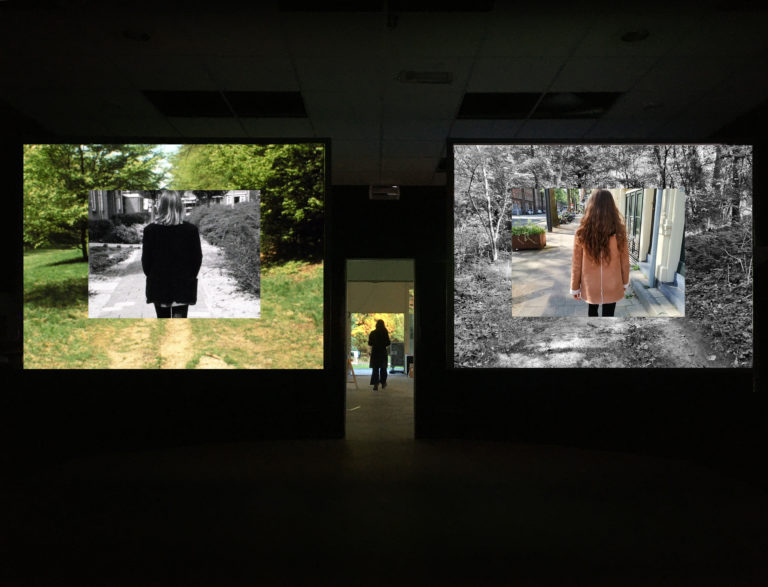
Photo: Iris Hoppe
Iris Hoppe, Rundgang / Circular walk / Circuit 2020
Circular walk is based on a film installation made in 1996 that consists of two Super-8 films projected into each other, an image within an image, recorded from two different points of view during the artist’s walk through streets in Amsterdam and the surrounding area. In the re-staging, Iris Hoppe’s daughter walks through the same streets of that time. The two walks are placed parallel to each other in the new work. An experience of multiple conjunctions about the meaning of time. This film installation with 4 projection screens is presented in the back room of the Glass House.
About the artist
Iris Hoppe born in 1970 in Solingen (DE) studied autonomous visual arts at the Gerrit Rietveld Academy in Amsterdam. Hoppe’s work includes time-bound installations, participatory art in public space, in situ and performance. She examines different types of boundaries, such as those between people, mental boundaries, spatial boundaries and those of art spaces and artistic productions. A methodological feature in her work is the inclusion of family members, friends, colleagues or passers-by as direct protagonists of the projects.
irishoppe.com
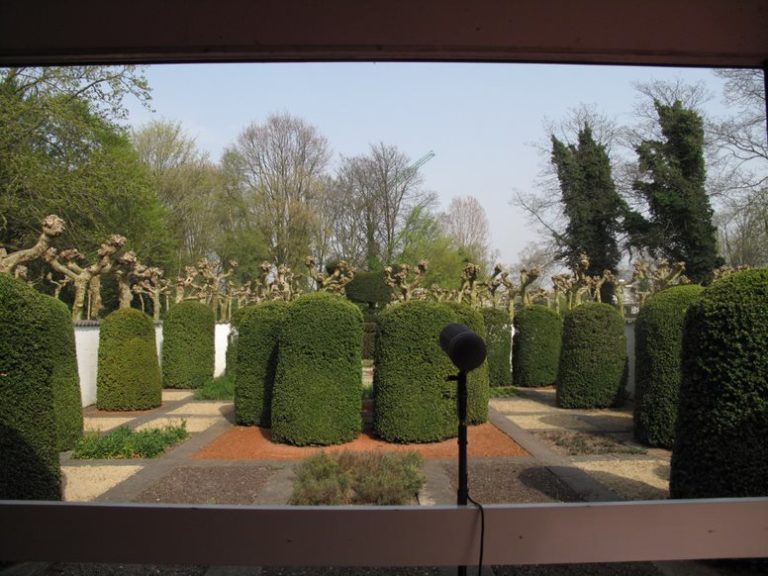
Photo: Justin Bennett
Justin Bennett, Secret Garden
Secret Garden is an audio walk that was originally developed for Zone2Source in 2015 and is being reactivated for this occasion. By using an app and headphones, listeners are free to experience the hidden layers of sound of the Amstelpark. The sounds were all recorded on location using a wide variety of techniques that explore the limits of audibility. Vibrations in plants and trees, hidden echoes and the calls of underwater insects form the soundtrack of the walk.
Justin Bennett (1964, UK) studied sculpture and electronic music and works with sound and image. His work with sound combines spatial recordings of ambient sound with the resonances of buildings and materials. He often uses these recordings with spoken word to immerse the audience in a story or subtly change the experience of a place. Bennett makes work for public spaces and for art institutions and concert venues. He teaches at the Institute of Sonology and is a member of Jubilee, a platform for artistic research in Brussels.
For Secret Garden, download the Echoes app and the walk via https://explore.echoes.xyz/collections/tVCCGRHPeN5hmnxs
justinbennett.nl
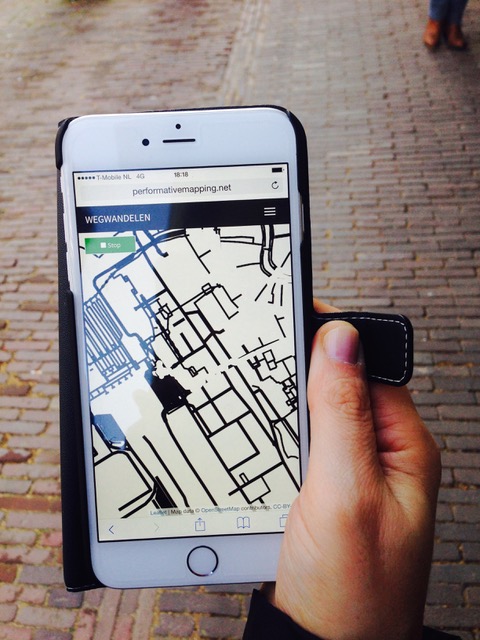
Photo: Naomi Bueno de Mesquita
Naomi Bueno de Mesquita, WalkAway
Go to instructions
Using a map interface, people can clear the map of their city along their walking routes. With this work, artist and (design) researcher Naomi Bueno de Mesquita points out the participatory quality of performative cartography (which is partly the result of the digitization of maps and mapping software) and emphasizes how digital maps in particular can be used in real time as a instrument that enables collective co-authorship regarding public space, representation and appropriation.
Through the ability to erase the map, the map interface is examined for its potential to work against the idea of control inherent in map making, both as a form of navigation and in practices such as data aggregation and data sharing. accumulation. A physical movement in what Henri Lefebvre (1991) calls ‘lived space’ continuously overwrites ‘thought space’ – the space that is theorized, like that of a map – with which the map app makes it possible to question deeply rooted dispositions that we have when it comes to what a card should be or do.
The evolving (removal of the) digital map and videos that users are invited to along their itinerary can be viewed continuously on three screens outside the Glass House or by visiting a website. Participants in this project become the authors of the map and thus jointly decide how the map evolves during the two months that the exhibition takes place, while the videos provide insight into individual motifs and/or the experiences of erasure. The maps app can be used anywhere and anytime in the city of Amsterdam during the two-month Mind Your Step exhibition. No registration is required to use the map app so users remain anonymous.
This work is part of the PhD by Naomi Bueno de Mesquita (KU Leuven) on critical cartography and performative modes in cartography as a means to reconnect with the (physical) public space. Performative cartography refers to the performative turn in cartographic theory, where maps are studied as (interactive) performances and as products of co-creations between maps and users. Bueno de Mesquita designs and uses map apps as a research method. Together with the public / users, she tries to ask questions about representation and (in)visibility with the ultimate goal of redefining public space and its social constructions.
ROAD WALKING
Using a map interface, people can clear the map of their city along their walking routes. A physical movement in space with which the map app questions deep-seated assumptions we have when it comes to what a map should be or do.
mindyourstep.performativemapping.net
performativemapping.com
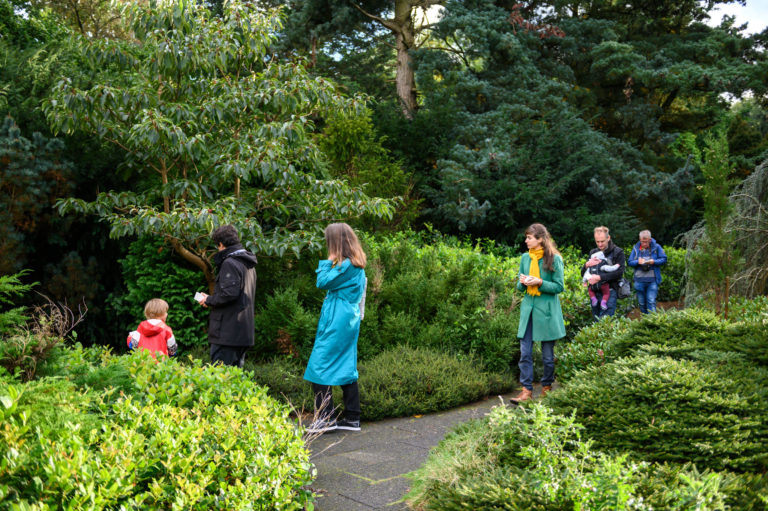
Photo: Tom Janssen
Liesje van den Berk,
Register Line – off – line (drawing walk).
Take one step, draw one line, everything is possible on a blank paper.
Leave your digital bubble and leave your phone behind. Feel, see, smell, listen and experience with your pencil on this drawing walk.
In the performative drawing walk “Line – off − line” you and Liesje enter into a dialogue with the Amstelpark and each other through drawing actions. Everything is possible on a white paper. Leave your safe digital bubble and leave your phone behind. Feel, see, smell, listen and experience with your pencil on this drawing walk.
This performance was created as a response to telephone use in our current society. We hold our phone like a precious object. Few mutual conversations or open looks when we are on the road, but desperate staring at the phone in search of contact elsewhere. Where are we? Through the telephone we are often in multiple worlds and realities at the same time, but are we still really HERE?
In this walk, Liesje van den Berk asks the participants to temporarily replace their telephone with a blank paper telephone and graphite pencil to walk and draw in silence and concentration in the Amstelpark. At some points during the walk, Liesje gives specific sensory drawing assignments. In this performance, drawing is a way to actively experience the richness of your environment and make contact. Through sharing drawings, Liesje creates a dialogue about the environment between the participants. Slowly the individuals become a group. At the end, the participants share one of their drawings on a map of the Amstelpark. These drawings remain behind in the Amstelpark to show a part of the walk, a memory of a moment, to the other visitors to the Amstelpark
About the artist
In her (drawing) performances and drawings, Liesje van den Berk creates a moment for dialogue, often non-verbal, where she focuses on personal contact, attentive presence and physical, sensitive involvement of herself and the audience. This creates dialogues, not only with other people (through performances), but also with the environment (through drawings and performances). Liesje van den Berk has developed the drawing method Drawalks to observe and record the environment through sensory experiences and (walking) drawing. The focus is often on senses other than sight – such as smell, sound and touch – to gain new perceptions of the environment.
liesjeberk.nl
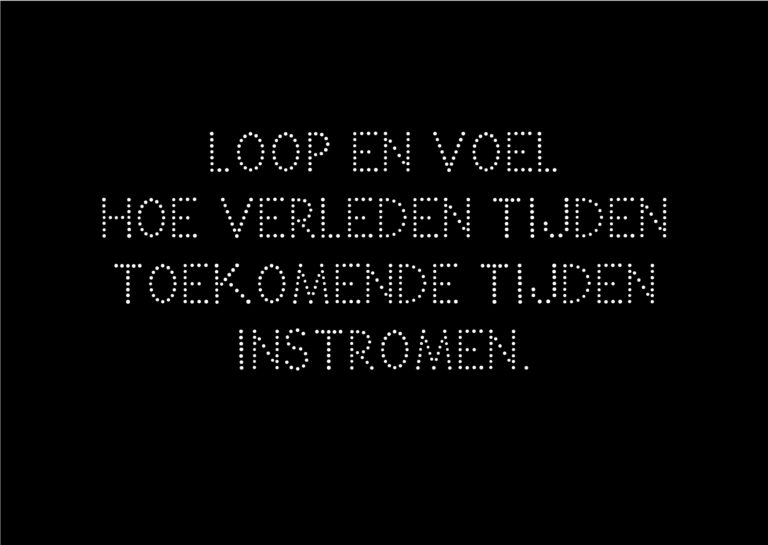
Isolde Venrooy, Pathfinder
Pathfinder consists of ten screen-printed maps with walking instructions, a handmade paper object and a map that are available in and outside the Glass House. The texts on the maps focus on the senses of the walker in various ways – questioning or invitingly instructing. The instructions encourage a short action or thought movement that activates the senses and gets the body and mind moving. The resulting walks in the Amstelpark offer new opportunities for relationships and connections between the visitor and her environment. The simple clues function as poetic proposals for alternative scenarios that can be brought to fruition. They invite the participant to act: activate, anticipate, intertwine, understand. By walking slightly differently, automatisms are examined and alternative possibilities are explored. The walks ‘unfilter’ looking and expand it with other ways of observing.
Pathfinder is about sensitively observing and experiencing alternatives to self-evident starting positions – and about the pleasure of discovery. The walking instructions are inspired by a mutual relationship between text and place. Renewed interest in her Indian family history has made Isolde think again about the relationship between body and place and the influence of language on perception.
About the artist
Isolde Venrooy’s artistic practice includes paintings, installations and walks. Her interest in walking arose because she hoped to create interactions between her visual work, the human body and the environment. In her artistic practice, walking is a medium and so-called viewing tools focus the senses. In addition to moving, holding still, determining position, looking and continuing to walk, the viewing tools function as extensions of perception.
isoldenrooy.com
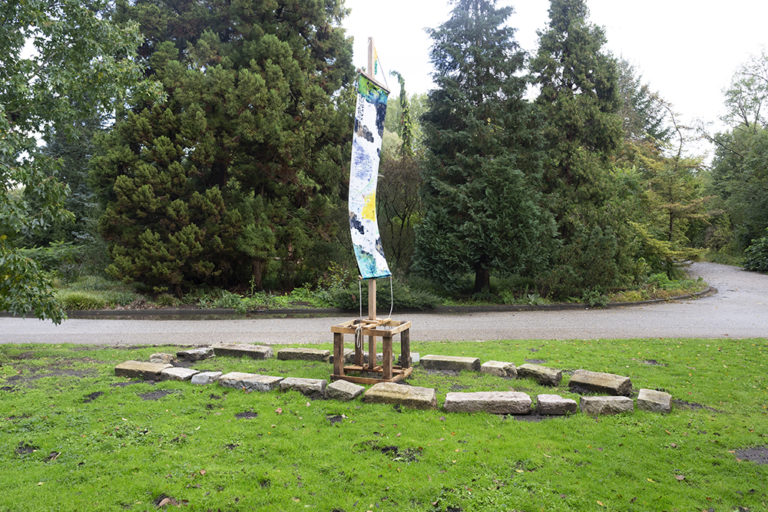
Image: Ilya Rabinovich
Chikako Watanabe, Journey to Meet Star-Gazers, Amsterdam, 2020
Chikako learned to make nets from a fisherman in Enkhuizen. She has been using this technique in
her works ever since. In 2019 she made nets with residents of the region around the sacred mountain
Myoken in Japan. She researched the environment and its history and made
connections between different traditions in her work. For example, she connected the religious
significance of the place with the customs of fishermen and nomads, who
orient themselves by the stars.
For Mind Your Step, Chikako is conducting the same research into the history of the
Amstelpark area. She read a legend about the origins of Amsterdam: in the 12th century, two fishermen and their two dogs landed in a small boat on the banks of the
Amstel and founded a fishing village there. While walking through the Amstelpark and along the Amstel,
she plots imaginary paths full of stories. Visitors to the park follow the nets
hung from trees to share the stories from East to West. Chikako is building an
installation outside the Glass House that she further develops during the exhibition, and
in which she literally weaves together old stories of the Amstel, Amsterdam and Japan.
This provides an incentive to go out in and around the park.
About the artist
After Japanese artist Chikako Watanabe moved to Amsterdam in 1995, she
created new work in many different places by learning from local residents. By
using media such as fashion, drawing, photography and video, she created installations that
functioned as interactive platforms, where she collaborates with different people in
the form of performances and workshops. Her theme is always local communication. The aim
of her projects is to stimulate social interaction and create new
communication possibilities for people within modern society. Small
issues and curiosity about everyday life are her main inspiration.
chikahome.nl
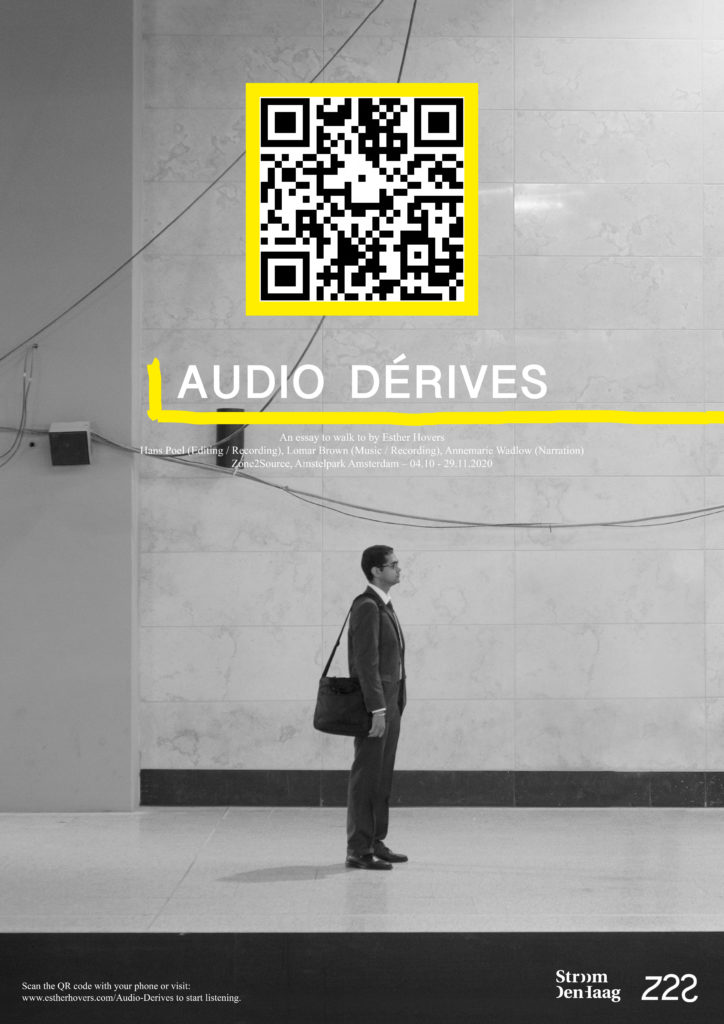
Esther Hovers, Audio Dérives
In Audio Dérives the audience turns into the performer. This audio walk takes the listener from the Amstelpark to the Amsterdam Zuidas. Guy Debord’s Théorie de la Dérive (1956) is central to the storyline. While walking, the listener reflects on the immediate environment and architecture of the neighborhood. This audio experience approaches the city walk as a form of poetry.
The solitary walk has taken on a different meaning during the pandemic. As the digital world only became more dominant, public space turned into one of the few places to experience art in a safe, physical way. Audio Dérives uses text and music – written especially for the project – to exchange digital space for a walk through the city. This audio walk can be walked at any time during the week with your own smart phone and headphones by downloading a QR code on a poster hanging outside the Glass House that is the starting point of the walk.
Download via the QR Code or via https://estherhovers.com/Audio-Derives
Concept / Script – Esther Hovers, Edit / Recording – Hans Poel, Music / Recording – Lomar Brown, Narrator – Annemarie Wadlow.
About the artist
In her work, Esther Hovers investigates how power, politics and control are expressed in the design of public space. She was trained as a photographer but creates installations in which photography, drawings, text and film have an equal share.
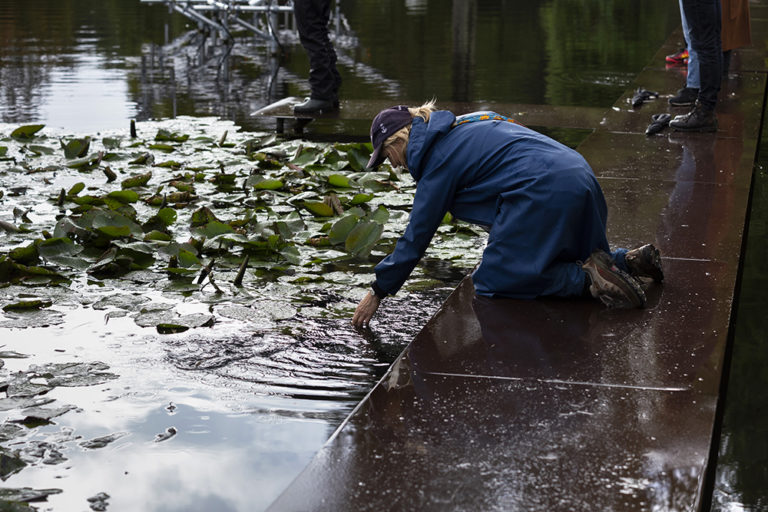
Image: Ilya Rabinovich
Malú Cayetano & Sonia Pérez
CITY IN BODY: Part II. Register atmospheres (body as a sensor).
This project aims to explore the indivisible relationship between body and landscape through the concept of “atmosphere”. Atmospheres are felt, they shape experiences that require spatial settings, human bodies, external events, shared meanings and histories. This concept allows us to overcome the polarity between subject and object, body and environment: we are immersed in atmospheres, always influenced by them. For Mind Your Step, the artists explore the spatial atmospheres of the Amstelpark and surroundings, using the body as an instrument to sense the environment and create an embodied and affective experience of the park.
The artists design a routine to accompany participatory walks through the park during the exhibition period. The routine consists of a series of exercises rooted in Body Weather, which promote the feeling of being with other beings and things in a shared space. These experiences are silently recorded using a wearable device. The device will have several sensors that can record numerous parameters. These are spatially linked to the park and added to a responsive map that can be seen in the Glass House. This cartography should be understood as a continuous visualization of possible atmospheres in the Amstelpark; it will evolve thanks to the active participation of the public in the walks.
City in Body is a project by Malú Cayetano (landscape architect) in collaboration with Sonia Pérez (actress and performer).
Malú Cayetano Molina: https://la-pa.es/
Sonia Pérez Olmedillo: https://soniaperezolmedillo.com/
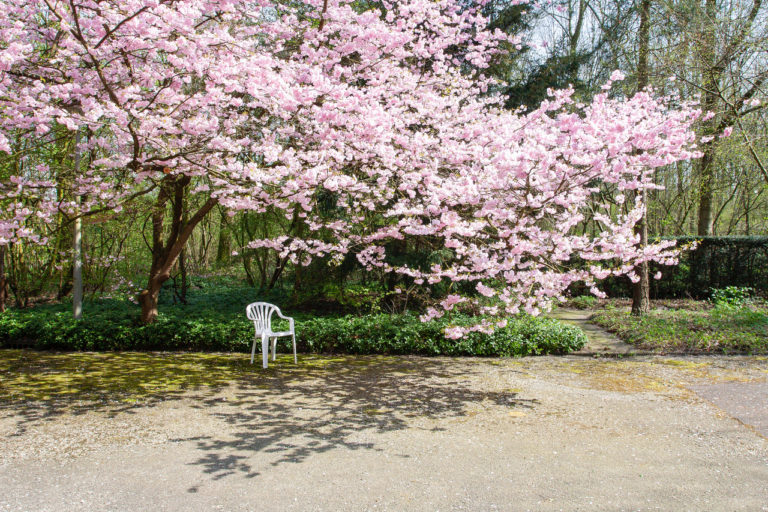
Photo: Ienke Kastelein
Register Ienke Kastelein
Don’t walk into the woods at night….
There are vulnerabilities associated with walking – one must beware of the dangers in the dark. You can get lost in a forest and all kinds of things are hidden behind trees.
The forest resides in our subconscious.
At nightfall, when the hour of the wolf arrives, the spell unfolds.
As the light slowly fades and contours fade, our nose and ears take over from our eyes.
Don’t walk into the woods at night…. is a stimulating evening walk in silence at nightfall, in the Amstelpark after closing time.
We carefully touch tree bark. We wander between bushes and trees, feel the ground with our feet, gaze at the sky and allow ourselves to be intoxicated by the smell of early autumn soil. A wordless conversation may arise between plants, people and trees.
Walking White Chairs
Walking, wandering, lingering –
Twelve white chairs in the Amstelpark – anyone who wants can take a chair, sit down for a while,
or take a chair elsewhere in the park to sit there.
The white chairs are a sanctuary, a sign of presence, an opportunity to stay and reflect. This is how people and chairs walk in the park.
How do people choose a place? How does a chair end up somewhere?
What route do the chairs take?
Background
This project resonates with the ‘white bicycle plan’ of the Provo movement from 1965, a bicycle sharing system in which free white bicycles would be placed in collective ownership in the city.
It is an investigation into the relationship between people and place, beaten and untrodden paths.
A fun way to create a place from a sensory and social involvement and from a scenographic perspective.
ienkekastelein.nl
Read the exhibition flyer here.
The exhibition Mind Your Step was made possible by the Municipality of Amsterdam, Prince Bernard Cultural Fund, Mondriaan Fund, AFK and Stroom.
het Glazen Huis